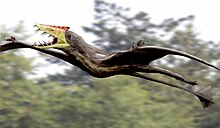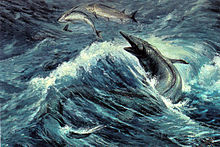Mesozoic
| Mesozoic Era | |||||||||||||||||||
|---|---|---|---|---|---|---|---|---|---|---|---|---|---|---|---|---|---|---|---|
| Chronology | |||||||||||||||||||
The Mesozoic Era The era began in the wake of the non-avian dinosaurs, pterosaurs, mosasaurs, and plesiosaurs. The Mesozoic was a time of significant tectonic, climatic, and evolutionary activity. The supercontinent Pangaea began to break apart into separate landmasses. The climate of the Mesozoic was varied, alternating between warming and cooling periods. Overall, however, the Earth was hotter than it is today.
Dinosaurs first appeared in the Mid-Triassic, and became the dominant terrestrial vertebrates in the Late Triassic or Early Jurassic, occupying this position for about 150 or 135 million years until their demise at the end of the Cretaceous. Flowering plants appeared in the Early Cretaceous and would rapidly diversify throughout the end of the era, replacing conifers and other gymnosperms (sensu lato), like Ginkgoales, cycads and Bennettitales as the dominant group of plants.
NamingThe phrase "Age of Reptiles" was introduced by the 19th century paleontologist Gideon Mantell who viewed it as dominated by diapsids such as Iguanodon, Megalosaurus, Plesiosaurus, and Pterodactylus. The current name was proposed in 1840 by the British geologist John Phillips (1800–1874). "Mesozoic" literally means 'middle life', deriving from the Greek prefix meso- (μεσο- 'between') and zōon (ζῷον 'animal, living being').[4][5] In this way, the Mesozoic is comparable to the Cenozoic (lit. 'new life') and Paleozoic ('old life') Eras as well as the Proterozoic ('earlier life') Eon. The Mesozoic Era was originally described as the "secondary" era, following the "primary" (Paleozoic), and preceding the Tertiary.[6] Geologic periodsFollowing the Paleozoic, the Mesozoic extended roughly 186 million years, from 251.902 to 66 million years ago when the periods . From oldest to youngest:
The lower boundary of the Mesozoic is set by the Chicxulub Crater on the Yucatán Peninsula. Towards the Late Cretaceous, large volcanic eruptions are also believed to have contributed to the Cretaceous–Paleogene extinction event.[10] Approximately 50% of all genera became extinct, including all of the non-avian dinosaurs.
TriassicThe Triassic ranges roughly from 252 million to 201 million years ago, preceding the Jurassic Period. The period is bracketed between the Permian–Triassic extinction event and the Triassic–Jurassic extinction event, two of the "big five", and it is divided into three major epochs: Early, Middle, and Late Triassic.[11]
The Early Triassic, about 252 to 247 million years ago, was dominated by deserts in the interior of the Pangaea supercontinent. The Earth had just witnessed a massive die-off in which 95% of all life became extinct, and the most common vertebrate life on land were The Middle Triassic, from 247 to 237 million years ago, featured the beginnings of the breakup of Pangaea and the opening of the ichthyosaurs and nothosaurs. On land, pine forests flourished, as did groups of insects like mosquitoes and fruit flies. Reptiles began to get bigger and bigger, and the first crocodilians and dinosaurs evolved, which sparked competition with the large amphibians that had previously ruled the freshwater world, respectively mammal-like reptiles on land.[13]
Following the bloom of the Middle Triassic, the Late Triassic, from 237 to 201 million years ago, featured frequent heat spells and moderate precipitation (10–20 inches per year). The recent warming led to a boom of dinosaurian evolution on land as the continents began to separate from each other (Nyasasaurus from 243 to 210 million years ago, approximately 235–30 ma, some of them separated into Sauropodomorphs, Theropods and Herrerasaurids), as well as the first flood basalt eruptions at the Central Atlantic magmatic province is cited as one possible cause.[16][17][18]
Jurassic The Jurassic ranges from 200 million years to 145 million years ago and features three major epochs: The Early Jurassic, the Middle Jurassic, and the Late Jurassic.[19] The Early Jurassic spans from 200 to 175 million years ago. The Middle Jurassic spans from 175 to 163 million years ago.[19] During this epoch, dinosaurs flourished as huge herds of sauropods, such as Brachiosaurus and Diplodocus, filled the fern prairies, chased by many new predators such as Allosaurus. Conifer forests made up a large portion of the forests. In the oceans, plesiosaurs were quite common, and ichthyosaurs flourished. This epoch was the peak of the reptiles.[20][failed verification][self-published source]  The Late Jurassic spans from 163 to 145 million years ago. CretaceousThe Cretaceous is the longest period of the Mesozoic, but has only two epochs: Early and Late Cretaceous.[21]  The Early Cretaceous spans from 145 to 100 million years ago. The Late Cretaceous spans from 100 to 66 million years ago. The Late Cretaceous featured a cooling trend that would continue in the Deccan traps and other volcanic eruptions were poisoning the atmosphere. As this continued, it is thought that a large meteor smashed into earth 66 million years ago, creating the Chicxulub Crater in an event known as the K-Pg Extinction (formerly K-T), the fifth and most recent mass extinction event, in which 75% of life became extinct, including all non-avian dinosaurs.[23][24][25]
Paleogeography and tectonicsCompared to the vigorous convergent plate Khingan Mountains in Manchuria.
This orogeny was related to the opening of the Atlantic coastline (such as along the U.S. East Coast) today.[27]
By the end of the era, the continents had rifted into nearly their present forms, though not their present positions. Himalayas .
ClimateThe Triassic was generally dry, a trend that began in the late Carnian Pluvial Event and one in the Rhaetian , a few million years before the Triassic–Jurassic extinction event.
Sea levels began to rise during the Jurassic, probably caused by an increase in seafloor spreading. The formation of new crust beneath the surface displaced ocean waters by as much as 200 m (656 ft) above today's sea level, flooding coastal areas. Furthermore, Pangaea began to rift into smaller divisions, creating new shoreline around the Tethys Ocean. Temperatures continued to increase, then began to stabilize. Humidity also increased with the proximity of water, and deserts retreated. The climate of the Cretaceous is less certain and more widely disputed. Probably, higher levels of Different studies have come to different conclusions about the amount of oxygen in the atmosphere during different parts of the Mesozoic, with some concluding oxygen levels were lower than the current level (about 21%) throughout the Mesozoic,[31][32] some concluding they were lower in the Triassic and part of the Jurassic but higher in the Cretaceous,[33][34][35] and some concluding they were higher throughout most or all of the Triassic, Jurassic and Cretaceous.[36][37] LifeFloragrasses becoming widespread in the Late Cretaceous. Flowering plants appeared late in the era but did not become widespread until the Cenozoic .The dominant land plant species of the time were angiosperms. The earliest members of the genus Ginkgo first appeared during the Middle Jurassic. This genus is represented today by a single species, Ginkgo biloba.[38] Modern conifer groups began to radiate during the Jurassic.[39] Bennettitales, an extinct group of gymnosperms with foliage superficially resembling that of cycads gained a global distribution during the Late Triassic, and represented one of the most common groups of Mesozoic seed plants.[40]
Schizeales, a fern order, were skewed to the Northern Hemisphere in the Mesozoic, but are now better represented in the Southern Hemisphere.[41]
Fauna The extinction of nearly all animal species at the end of the dicynodonts , the latter of which subsequently became extinct.
Recent research indicates that it took much longer for the reestablishment of complex ecosystems with high biodiversity, complex food webs, and specialized animals in a variety of niches, beginning in the mid-Triassic 4 million to 6 million years after the extinction,[42] and not fully proliferated until 30 million years after the extinction.[43] Animal life was then dominated by various archosaurs: dinosaurs, pterosaurs, and aquatic reptiles such as ichthyosaurs, plesiosaurs, and mosasaurs. The climatic changes of the late Jurassic and Cretaceous favored further adaptive radiation. The Jurassic was the height of archosaur diversity, and the first birds and eutherian mammals also appeared. Some have argued that insects diversified in symbiosis with angiosperms, because insect anatomy, especially the mouth parts, seems particularly well-suited for flowering plants. However, all major insect mouth parts preceded angiosperms, and insect diversification actually slowed when they arrived, so their anatomy originally must have been suited for some other purpose.[citation needed] MicrobiotaAt the dawn of the Mesozoic, ocean plankton communities transitioned from ones dominated by green archaeplastidans to ones dominated by endosymbiotic algae with red-algal-derived plastids. This transition is speculated to have been caused by an increasing paucity of many trace metals in the Mesozoic.[44] See alsoReferences
External linksWikisource has original works on the topic: Mesozoic Wikimedia Commons has media related to Mesozoic. | |||||||||||||||||||
